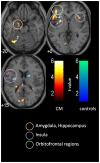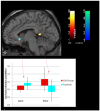Women with a history of childhood maltreatment exhibit more activation in association areas following non-traumatic olfactory stimuli: a fMRI study
- PMID: 20179758
- PMCID: PMC2825260
- DOI: 10.1371/journal.pone.0009362
Women with a history of childhood maltreatment exhibit more activation in association areas following non-traumatic olfactory stimuli: a fMRI study
Abstract
Background: The aim of this study was investigating how women with a history of childhood maltreatment (CM) process non-threatening and non-trauma related olfactory stimuli. The focus on olfactory perception is based on the overlap of brain areas often proposed to be affected in CM patients and the projection areas of the olfactory system, including the amygdala, orbitofrontal cortex, insula and hippocampus.
Methods: Twelve women with CM and 10 controls participated in the study. All participants were, or have been, patients in a psychosomatic clinic. Participants underwent a fMRI investigation during olfactory stimulation with a neutral (coffee) and a pleasant (peach) odor. Furthermore, odor threshold and odor identification (Sniffin' Sticks) were tested.
Principal findings: Both groups showed normal activation in the olfactory projection areas. However, in the CM-group we found additionally enhanced activation in multiple, mainly neocortical, areas that are part of those involved in associative networks. These include the precentral frontal lobe, inferior and middle frontal structures, posterior parietal lobe, occipital lobe, and the posterior cingulate cortex.
Conclusions: The results indicate that in this group of patients, CM was associated with an altered processing of olfactory stimuli, but not development of a functional olfactory deficit. This complements other studies on CM insofar as we found the observed pattern of enhanced activation in associative and emotional regions even following non-traumatic olfactory cues.
Conflict of interest statement
Figures



Similar articles
-
Altered olfactory processing of stress-related body odors and artificial odors in patients with panic disorder.PLoS One. 2013 Sep 24;8(9):e74655. doi: 10.1371/journal.pone.0074655. eCollection 2013. PLoS One. 2013. PMID: 24086358 Free PMC article.
-
PTSD, but not childhood maltreatment, modifies responses to unpleasant odors.Int J Psychophysiol. 2010 Mar;75(3):326-31. doi: 10.1016/j.ijpsycho.2010.01.003. Epub 2010 Jan 15. Int J Psychophysiol. 2010. PMID: 20079770
-
Impaired brain response to odors in patients with varied severity of olfactory loss after traumatic brain injury.J Neurol. 2018 Oct;265(10):2322-2332. doi: 10.1007/s00415-018-9003-8. Epub 2018 Aug 14. J Neurol. 2018. PMID: 30109478
-
The neuronal correlates of intranasal trigeminal function-an ALE meta-analysis of human functional brain imaging data.Brain Res Rev. 2010 Mar;62(2):183-96. doi: 10.1016/j.brainresrev.2009.11.001. Epub 2009 Nov 11. Brain Res Rev. 2010. PMID: 19913573 Free PMC article. Review.
-
Olfactory system and emotion: common substrates.Eur Ann Otorhinolaryngol Head Neck Dis. 2011 Jan;128(1):18-23. doi: 10.1016/j.anorl.2010.09.007. Epub 2011 Jan 11. Eur Ann Otorhinolaryngol Head Neck Dis. 2011. PMID: 21227767 Review.
Cited by
-
Gray Matter Alterations Associated With Dissociation in Female Survivors of Childhood Trauma.Front Psychol. 2019 Apr 5;10:738. doi: 10.3389/fpsyg.2019.00738. eCollection 2019. Front Psychol. 2019. PMID: 31024390 Free PMC article.
-
Neuroimaging of child abuse: a critical review.Front Hum Neurosci. 2012 Mar 19;6:52. doi: 10.3389/fnhum.2012.00052. eCollection 2012. Front Hum Neurosci. 2012. PMID: 22457645 Free PMC article.
-
Inflammation and olfactory loss are associated with at least 139 medical conditions.Front Mol Neurosci. 2024 Oct 11;17:1455418. doi: 10.3389/fnmol.2024.1455418. eCollection 2024. Front Mol Neurosci. 2024. PMID: 39464255 Free PMC article.
-
Olfactory loss is a predisposing factor for depression, while olfactory enrichment is an effective treatment for depression.Front Neurosci. 2022 Sep 28;16:1013363. doi: 10.3389/fnins.2022.1013363. eCollection 2022. Front Neurosci. 2022. PMID: 36248633 Free PMC article.
-
Dissociated representations of pleasant and unpleasant olfacto-trigeminal mixtures: an FMRI study.PLoS One. 2012;7(6):e38358. doi: 10.1371/journal.pone.0038358. Epub 2012 Jun 12. PLoS One. 2012. PMID: 22701631 Free PMC article.
References
-
- Fonagy P, Leigh T, Steele M, Steele H, Kennedy R, et al. The relation of attachment status, psychiatric classification, and response to psychotherapy. J Consult Clin Psychol. 1996;64:22–31. - PubMed
-
- DeBellis MD, Keshavan MS, Clark DB, Casey BJ, Giedd JN, et al. Developmental traumatology part II: brain development. Biological Psychiatry. 1999;45:1271–1284. - PubMed
-
- DeBellis MD, Keshavan MS. Sex differences in brain maturation in maltreatment-related pediatric posttraumatic stress disorder. Neuroscience and biobehavioral reviews. 2003;27:103–117. - PubMed
Publication types
MeSH terms
Substances
LinkOut - more resources
Full Text Sources
Medical

